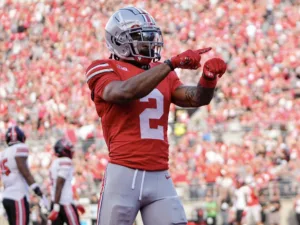
Can College Yards After Catch Help Predict NFL Success For Wide Receivers?
For our 61 part “Does It Matter?” series, we looked into whether a Wide Receiver’s College Yards After Catch per Reception (YAC/Rec)
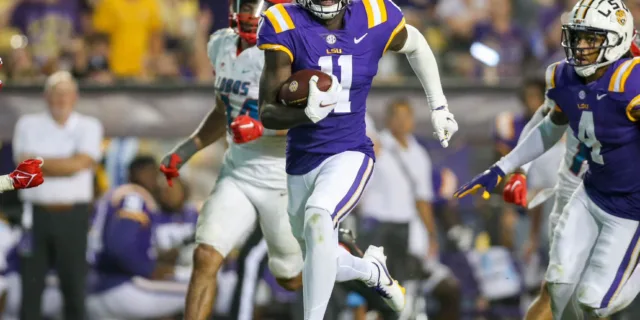
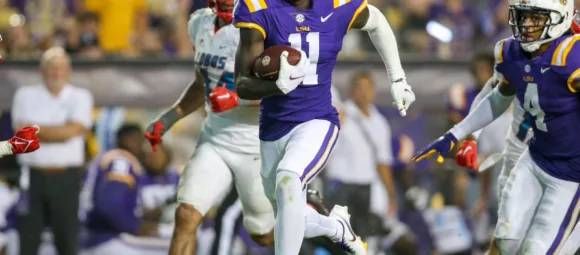
In our latest installment of the “Does It Matter?” series, we dove deep in the number crunching to reveal the impact of an NFL Wide Receivers’ height on their fantasy football performance. Our research in Part 4 has unveiled a range where the average top-performing receiver falls into. Essentially, this range is where more elite performances occur. Further, we found a critical range where prospects must measure above or else be considered a bust.
Our search for answers began with compiling the top 50 Fantasy Football PPR wide receivers for every year since 2003. To maintain consistency and try to eliminate variables, we sourced our data exclusively from NFL draft combine measurements. This approach allowed us to draw comparisons on a level playing field, examining how physical attributes measured at the beginning of careers influences future success.
The first step in our analysis was to calculate the average heights for the top 1, 5, 10, 11-30th and 31-50th place finishers for every season.

At first glance, the data hinted at a subtle trend: the top 5 finishers appeared on average to be slightly taller than the 11-30th and 31-50th finishers. Although, this trend was not clear enough to declare this conclusion.
Unsatisfied with the averages, we transitioned to a more segmented evaluation. Therefore, we plotted the heights of every top 10 NFL wide receiver since 2003 on a chart in 1/8 inch increments. Mirroring this, we also charted the bottom 10 NFL wide receivers to create a visual comparison. Both can be seen below:
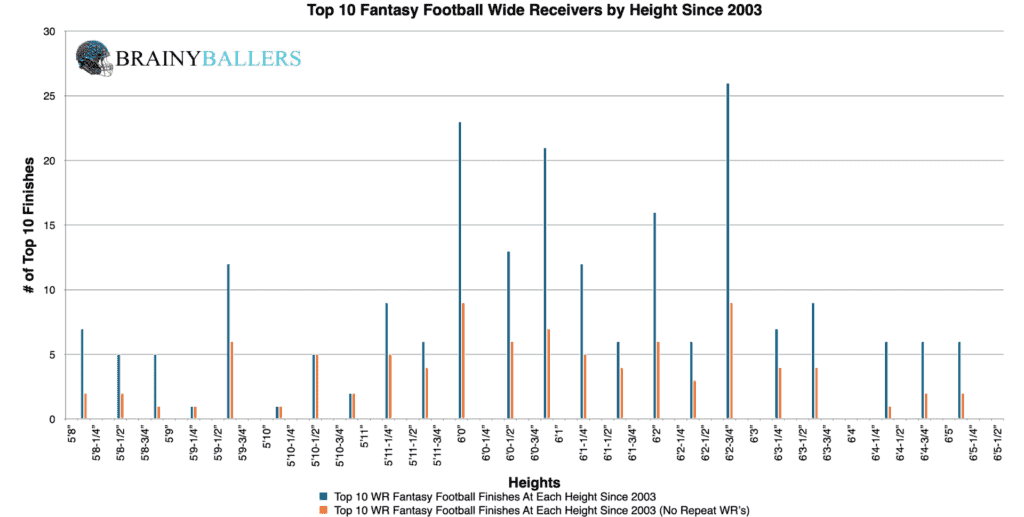
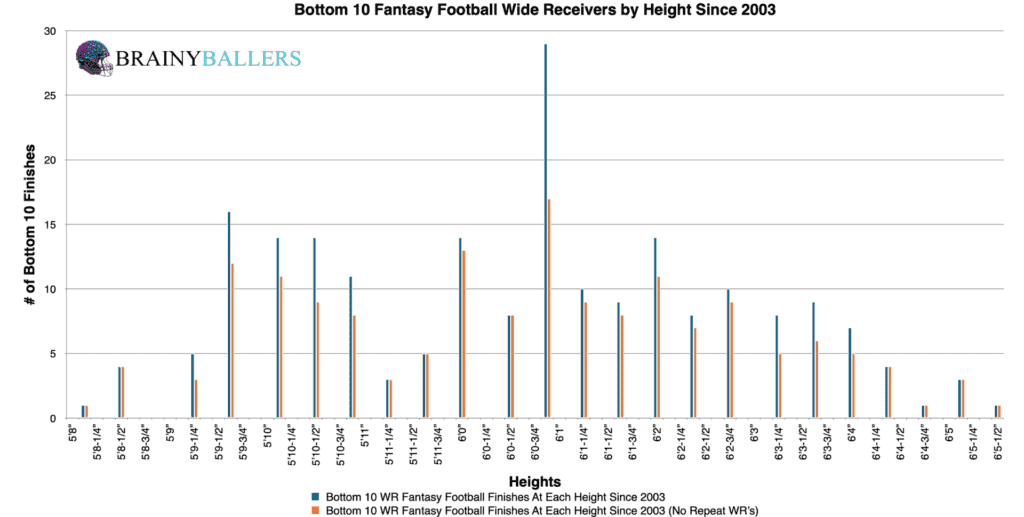
As performance increased, an increase in height at both the 6’0” and 6’2.75” marks became apparent. To solidify our findings, we constructed a differences chart. This compares each height segment (and the subsequent quarter inch) among the top finishers while subtracting the corresponding data from the bottom 10. Essentially, the Top 10 finishers chart minus the Bottom 10 Finishers chart (seen above) for each .25 inch beginning at the indicated height. This process revealed a significant range where height appears to be a predictive factor in a wide receiver’s performance. Between 5’11” and 6’2.75″ you’ll see the largest increase indicating higher performances within this threshold. Then you add the .25″ that this chart includes at the indicated height and you get a range from 5’11” to 6’3″ being the apparent optimal range.
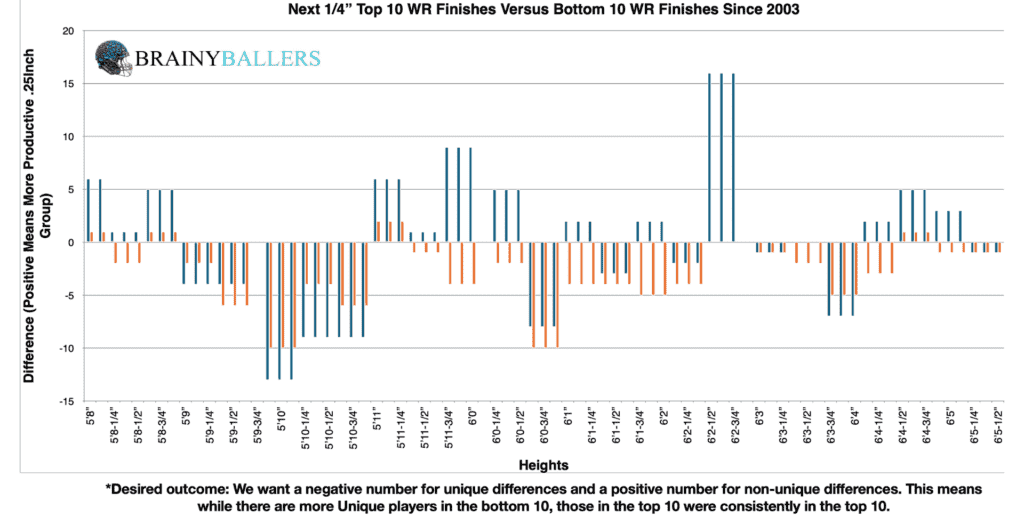
Our finding showcases what we term as the “optimal range” for receiver heights, spanning from 5’11” to 6’3”. This interval was identified as a common height range among top-performing receivers specifically. To verify or debunk this, we looked at all bottom 10 finishers and wanted to see what percentage of them fall with the identified range. This will set the baseline to compare to the top 10 finishers next. So here it is: Out of 210 bottom 10 finishers, 110 fell within this optimal range. This accounts for 52.4%.
We now compared this baseline to the heights of all top 10 finishers from 2003 to 2023. Out of 210 top 10 finishers, 138 fell within our height range, accounting for 65.7%, a 13.3% increase! Although this is great, we’re not done there, as we want to adjust this range to verify this as the top producing height range, which you will see next.
By fine-tuning this height range, we found that expanding the upper end of this range produces the same exact results. Therefore, the optimal height range for WR’s will be 5’11” to 6’3-1/8″. This range also occurs in the top 10 13.3% more frequently than the bottom 10 and will be the subject of this research going forward.
In pursuing further insights, we compared the prevalence of our optimal range across different decades, specifically looking at top 10, 11-40th, and bottom 10 finishers. The findings were as follows:
| 2004-2013 | |||
| Top 10 | 11 through 40 | Bottom 10 | |
| All count | 100 | 300 | 100 |
| Between 5’11” and 6’3-1/8” | 64 | 191 | 58 |
| % (hard zone/all) | 64.0% | 63.7% | 58.0% |
| 2014-2023 | |||
| Top 10 | 11 through 40 | Bottom 10 | |
| All count | 100 | 300 | 100 |
| Between 5’11” and 6’3-1/8” | 68 | 172 | 45 |
| % (hard zone/all) | 68.0% | 57.3% | 45.0% |
This decadal analysis suggests a significant shift towards receivers being higher performing within this hard range. This is seen by the 23.0% increase in the most recent decade, with only a 6.0% in the previous decade when going from bottom 10 to top 10 performers.
Height could play a small factor in our Star-Predictor Score (SPS) model. The Star-Predictor Score (SPS) is a scouting tool designed to maximize investment potential and reduce risks when drafting rookies in Fantasy Football. It is proven to have a higher accuracy than draft capital alone to predict fantasy success. The SPS includes 13 to 17 metrics, with the exact number varying by the player’s position. All these metrics are pre-NFL, and some are invented by us, providing a complete analysis of a player’s analytical profiles. The SPS gained widespread notoriety for its high accuracy, having made it on Barstool and The Pat McAfee Show. The SPS can be found here.

Next, we wanted to put all data points we accumulated up to the test of standard statistical methods. Here are those results:
To interpret this; there is no strong correlation between height and fantasy points. We are hoping for a minimum of 0.1, or an inverse correlation maximum of -0.1 when we study world-class athletes as we are. For reference to something that everyone acknowledges matters in prospect scouting, and to show the accompanying Pearson value, RB draft capital prevailed a -0.234 Pearson value.
What 3 metrics matter the most when scouting a rookie Quarterback? What threshold should Quarterbacks achieve within those metrics to be considered an elite prospect? How much should you value those stats above all other stats? Couldn't answer those questions? Rest easy, we have it handled for you. That's what this chart answers. Sort by importance and/or filter by position. Unlock by signing up with the links provided. $9.99/Year or $24.99 Lifetime access. Cancel anytime.
The exploration into NFL Receiver heights has revealed an optimal range which stands out as the more significant performance booster. This range is from 5’11” to 6’3-1/8″. By no means do we think if a player is outside the hard or soft range that they will not be a good NFL player, but using analytics to help aide your opinions on players is a smart tactic.
Stay tuned for our weekly data-driven explorations which will be released every Saturday. We will dive deep into the world’s most intriguing questions, bust myths, and settle debates with thorough analysis similar to this. We thrive on curiosity and welcome your input—so please, leave comments or reach out to us with topics you’re eager to see dissected next. All of our research can be found on our Analytics Page. Up next on our agenda for Part 5 of “Does It Matter?” is an examination of Wide Receiver Weights: Does that impact performance? If so, what’s the ideal weight for a WR? Your insights and questions fuel our research, so join us in this analytical journey. Mark your calendars; every Saturday we shed light on the topics that matter to you. All it takes is a short question and we will go to work for you!



For our 61 part “Does It Matter?” series, we looked into whether a Wide Receiver’s College Yards After Catch per Reception (YAC/Rec)

In part 60 of our “Does It Matter?” series, we dove into the question of whether a college Wide Receiver’s career Average

The “Does It Matter?” series, part 59 looked to uncover the role of a quarterback’s rookie touchdown per game (TD/G) in predicting
© 2023 BrainyBallers | All Rights Reserved